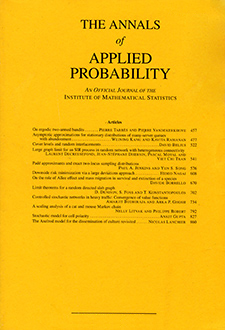Abstract
We propose a general method to study dependent data in a binary tree, where an individual in one generation gives rise to two different offspring, one of type 0 and one of type 1, in the next generation. For any specific characteristic of these individuals, we assume that the characteristic is stochastic and depends on its ancestors’ only through the mother’s characteristic. The dependency structure may be described by a transition probability P(x, dy dz) which gives the probability that the pair of daughters’ characteristics is around (y, z), given that the mother’s characteristic is x. Note that y, the characteristic of the daughter of type 0, and z, that of the daughter of type 1, may be conditionally dependent given x, and their respective conditional distributions may differ. We then speak of bifurcating Markov chains.
We derive laws of large numbers and central limit theorems for such stochastic processes. We then apply these results to detect cellular aging in Escherichia Coli, using the data of Stewart et al. and a bifurcating autoregressive model.
Citation
Julien Guyon. "Limit theorems for bifurcating Markov chains. Application to the detection of cellular aging." Ann. Appl. Probab. 17 (5-6) 1538 - 1569, October 2007. https://doi.org/10.1214/105051607000000195
Information





